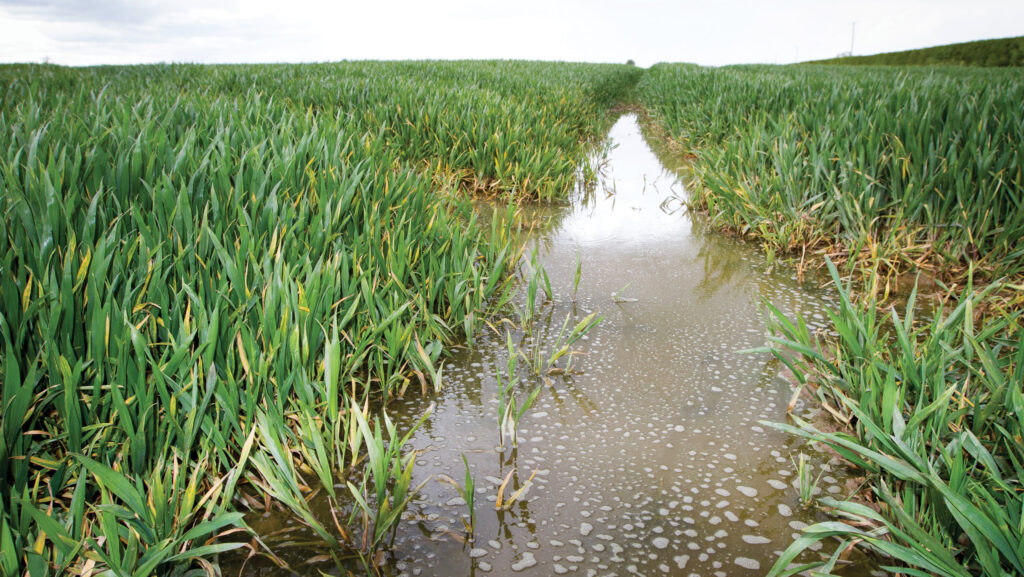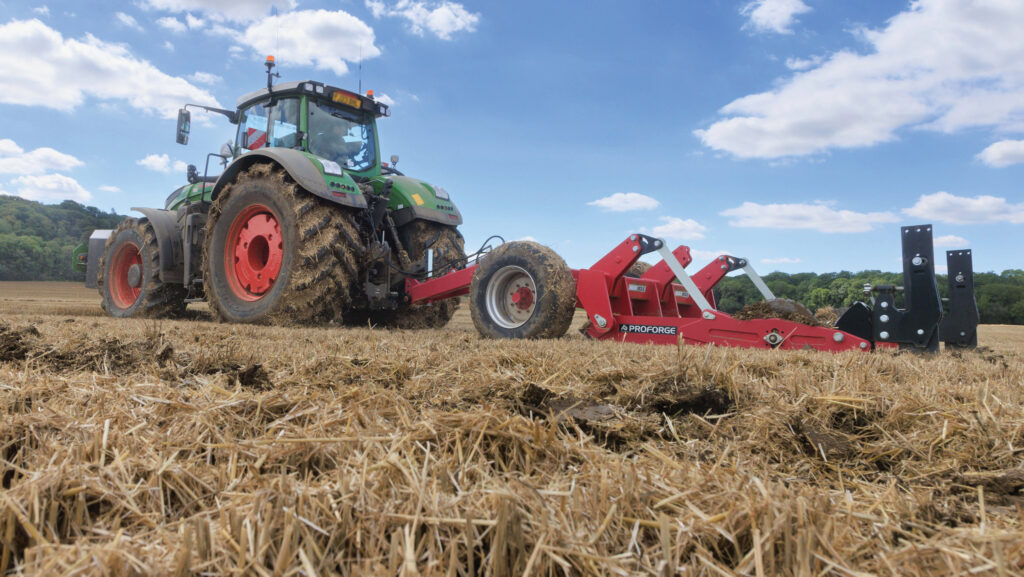Getting arable soils back on track after a washout season
 © GNP
© GNP Soils have been one of the biggest casualties of the wet season, with many fields requiring some remedial action before cropping again.
Issues vary from surface capping, slumping, compaction, and erosion/gullying to deep compaction, smearing and other structural issues, where ground has been travelled on or worked when wet.
“There’s quite a lot of work needed to set fields up to be cropped again,” says AICC/Arable Alliance agronomist, Andrew Wells, who covers the East Midlands, one of the worst affected areas.
See also: Eliminating chemicals helps future-proof pig and arable farm
“Some issues may not necessarily be expensive to fix, such as where there’s surface compaction in the top 7-12cm (3-4in), but in other cases, there are some fundamental drainage problems.”
He urges growers to use the spade to identify problems, note where they are – both within the profile and areas of the field – and then decide how to tackle them.
Remedial works
Cultivations or other remedial works should then be tailored to soil requirements to avoid making situations worse, Steve Cook of AICC/Hampshire Arable Systems adds.
“Many tramlines need some sort of subsoiling, for example, but this must be done in the right conditions and correct depth. Subsoiling when soil is still wet at depth won’t work and could exacerbate drainage problems.”
In wetter soils with higher clay content, mole ploughing may be effective where required, he says.
“We’ve seen a lot more mole ploughing in the past 3-4 years, and it can make quite a difference to drainage, but it’s a slow job that has to be done right.”
Andrew suggests more growers may plough this autumn, as it can aerate soil, relieve shallow compaction, and improve seed-bed resilience to intense rainfall.
It also offers a useful “reset” where there is high weed seed return at harvest and buries surface trash (chopped straw or cover crop residues).
“But again, its effectiveness depends on soil type and conditions.
“Ploughing can work well for alleviating compaction in the top 15-18cm (6-7in) on silty clays and sandy clay loams, but on heavier clays, it can sometimes be hard to create a seed-bed if soil is ploughed wet, then bakes dry.”
N-fixing seed treatment
For growers planning to drill early, it may be worth considering a new nutritional product that uses multispecies bacteria, applied as a pre-formulated liquid seed treatment.
It can convert atmospheric nitrogen into a useable form for plants, solubilise phosphorous, and improve nutrient cycling.
GramaxNP can be applied to any cereal, with or without other seed treatments, and has been shown to deliver the equivalent of 20-30kg N/ha across the season in on-farm trials by Certis Belchim.
“It contains a living bacterium that multiplies as roots grow, so offers season-long nutrient delivery, although activity declines over winter before increasing again in spring,” explains Adam Nears from Certis Belchim.
“We’ve seen strong responses in earlier-sown crops, where soil temperatures are higher, with some crops emerging quicker and putting on more root mass, tillers and biomass.”
The product has been trialled in standard nitrogen programmes, and reduced N situations.
Adam says it delivered a consistent 3:1 payback under the standard programmes – the yield benefit was worth three times the treatment cost at a wheat price of £180-200/t – and in reduced N trials, rates were cut by around 30kg N/ha with no yield penalty compared with the farm standard.
Recovering rotations
Many cropping plans have been disrupted this season, so the priority is to get rotations back on track quickly and try to recoup any lost revenue.
With winter wheat remaining the highest gross margin crop on most arable farms, it is widely anticipated the area of first and second wheats will recover this year, and after two consecutive autumns disrupted by the weather, there will be an urge to drill early.
But growers need to recognise the risks, especially this year.
“If, for example, you missed drilling a first wheat last autumn and had to put in spring barley instead, that spring cereal only provides a partial take-all break ahead of any ‘first wheat’ going in,” says Steve.
“I’d treat any wheat sown after spring wheat or barley as a second wheat.”
Andrew says a significant area of rotational Sustainable Farming Incentive (SFI) options has been grown this year, notably legume fallow (NUM3) and pollen and nectar mixes (ALH1), often as a first wheat entry. Managing these areas also needs care.
“SFI rules state you can’t destroy these covers until 1 September, by which time there could be a lot of plant biomass to deal with, depending on sowing date.”
Cover termination, residue incorporation, “green bridge” aphid transmission, establishment of following crops and slug and leatherjacket risks must all be considered, he says.
“It’s also worth noting glyphosate isn’t great at killing legumes on its own, so you’ll probably need a glyphosate + hormone product (2,4-D + glyphosate) to increase activity. Some also mow to reduce bulk, but it’s a slow process.”

© Tim Scrivener
Managing grassweeds
Pre- and post-emergence herbicide programmes are another victim of the weather on many farms, posing potential problems with high seed return, with issues exacerbated in patchy or thin crops.
Blackgrass remains the top concern, especially where pre-ems could not be applied and populations are resistant to Atlantis-type, post-emergence chemistry, says Steve.
“Unfortunately, a lot of blackgrass seed will go through to harvest, requiring serious ‘resetting’ on some farms. If delayed drilling isn’t possible, ploughing and a robust residual programme is the main option.”
Grassweed build-up is an ongoing concern in consecutive cereals given that available chemistry is very similar, adds Andrew.
“You can’t really do more than two autumn-sown cereals consecutively without putting a spring crop in to stop grassweed build up, even with current herbicides.”
Grassweeds, and cereal volunteers, can act as a “green bridge” for pests and diseases, such as aphids and take-all inoculum to transfer from one crop to another, so must be managed accordingly, he adds.
“We can’t ignore aphid-transmitted virus risk this year, particularly if farmers are looking to drill earlier.
“Combined with a significant area of insecticide-free SFI options, it’ll be interesting to see how that affects risk.”
Using old seed
Both agronomists recognise there is more unused over-yeared seed on farm (treated and untreated), so urge growers to get it tested for germination and vigour before sowing.
“Any seed can deteriorate, but it depends how it’s been stored,” says Andrew.
“Typically, germination might drop from 90% to 80%, but it can be more dramatic.
“Germination only tells part of the story – treated seed in particular may germinate, but can lack vigour, so it’s worth getting seed tested for both.”
Testing is relatively cheap and results can be used to adjust seed rates accordingly.
“Try to drill old seed first, as soon as conditions are good enough for rapid establishment.”
Certis Belchim’s Adam Nears reassures growers that any seed treatment on over-yeared seed should still be effective, as this longevity is required for regulatory approval.
Managing take-all
With growers likely to be eager to get on with drilling first wheats in September, then go straight into second wheats from early October, take-all pressure could be higher, especially where there has only been a partial break.
Risk could have been heightened by the mild winter, which allowed fungal mycelium to continue multiplying where soils remained above 5C, notes Certis Belchim’s Adam Nears.
“This risk will carry through to the next crop on any green bridge, whether that’s cereals, grassweeds, cover crops containing grasses or volunteers, so needs managing carefully.”
AICC/Arable Alliance agronomist, Andrew Wells recommends prioritising drilling order, putting earliest wheats into lower take-all risk situations (following oats, pulses or oilseed rape, for example), and consider treating second wheat seed with Latitude (silthiofam).
This “buys” flexibility to sow earlier than would be ideal from a take-all perspective, and still achieves similar yield.
“Normally you might drill second wheats from 10 October without Latitude, but with the seed treatment, you can bring that forward almost a couple of weeks,” Adam explains.
He says ensuring crops have a robust root structure is fundamental to optimising yield and building resilience for the season ahead.
Adam also points out the long-term yield response from Latitude over more than 20 years and 100+ trials averages around 0.55 t/ha, but can be more in higher-risk situations.
Use the company’s calculator here to show the yield needed to cover treatment cost.

